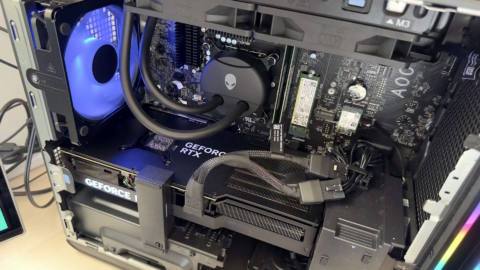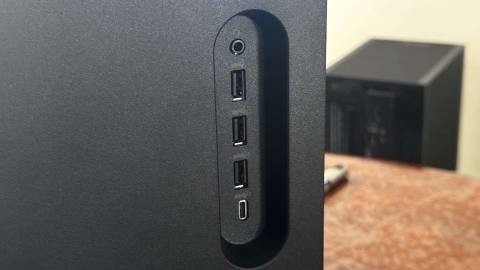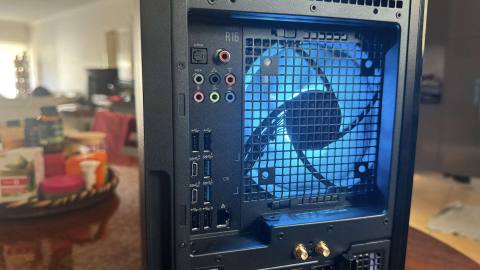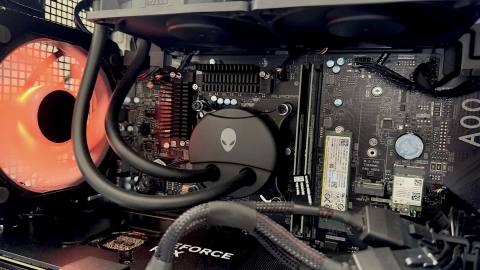Alienware introduced the latest version of its desktop gaming PC, the Aurora R16, in the middle of last year, marking a radically non-radical shift away from its Giger-inspired origins. This release goes beyond a mere plexiglass window addition, presenting an entirely new chassis design that will elicit either love or disdain.
According to Alienware, the redesign responds to the desires of loyalists seeking a simpler chassis that seamlessly fits into their setups and more easily accommodates aftermarket components. Alienware probably did too good a job on one front, making a machine that looks decidedly more earthly than Alien, but still failed on the other with a machine that still isn't as upgradeable as PC enthusiasts would like.
The new Aurora R16 starts at $1,300 (£1,349 and $2,800 AUD) and in typical Dell fashion, you can configure the machine with as low as a 13th Gen Intel i7 with Nvidia RTX 4060 all the way up to a range-topping 14th Gen Intel i9-14900F, RTX 4090, 64GB DDR5 and 8TB SSD for an absurd $5,300.
My review unit came furnished with a liquid cooled Intel Core i9 13900F, 32GB DDR5-5600 memory, a 512GB SSD, and 1TB 7200RPM HDD. Graphics power is provided by an Nvidia GeForce RTX 4080 though I couldn't make out exactly what brand is supplying Dell from the blank shroud around it. There's a new 240mm heat exchanger at the top of the case and a 120mm exhaust fan at the back.

CPU: 13th Gen Intel Core i9-13900F
Graphics: NVIDIA GeForce RTX 4080 16GB
Cooling: 240mm Alienware AIO
RAM: 32GB (2x16GB) DDR5 5600 MT/s
Storage: 512GB M.2 PCIe NVMe SDD + 1TB HDD
Power: 1000W
Warranty: 1 year
Price: $2799
Upgrading even this latest Alienware system can still be a bit tricky due to its proprietary motherboard and bespoke 1000w power supply. The motherboard offers only two DDR5 RAM slots and two M.2 SSD slots without heatsinks. It's quite basic, lacking necessary features, and the RAM and SSDs from Alienware come without heat spreaders, being simple barebones chips.
And speaking of those storage drives, Dell is being remarkably stingy when it comes to SSD capacity. Stuffing just a 512GB SSD into a machine that costs nearly three grand is not a good look at a time when 1TB drives are the minimum we would recommend for PC gamers.
Heading back outside to the case design, I'm not a fan of what Alienware did there. Cover the signature alien head logo and this could be any other RGB case from around the internet. Note that this is the first showcase of the company's new Legend 3 industrial design, and it's far from the more stylish Legend 2 Design Language that made the R15 and X16 laptops such standouts.
The new chassis comes only in black and is 40% smaller than the previous model, measuring 16.5 x 7.8 x 18.1 inches. Despite its compact size, it maintains a 25-liter capacity, accommodating large RTX 4090 GPUs. This makes it more convenient for my setup or theoretically even for a living room TV. The R16 features an acrylic side panel with a stylish honeycomb vent design for improved airflow while concealing cable clutter. However, the panel's sliding latch release system on the back, secured by a Philips-head screw, could certainly be simpler.



The front of the Aurora has an inch-wide gap that cleverly hides a front air intake while still giving you a solid panel with three 5Gbps USB Type-A ports, one 10Gbps Type-C, and an audio combo jack for easy access. The signature RGB ring can easily distract you from the gap and of course you can customize the glorious lighting.
There's a bunch more ports at the back, too, with a pair of 5Gbps USB-A, one 10Gbps USB-C, one 20Gbps USB-C, and four USB 2.0 plenty of audio outputs and an Ethernet 2.5Gps port—so connecting all your peripherals is rarely going to be an issue. The R16 supports WiFi6E and comes with a stocky, puck-like antenna which has great reception.
The standout feature of the new R16 design, however, is its significantly improved thermal performance. Unlike its predecessors, the R16 operates quietly even under heavy loads, maintaining this low noise level even in Performance mode. During stress tests and demanding benchmarks, such as Cyberpunk 2077 in 4K with Psycho ray-tracing, the R16 remained remarkably quiet, with both CPU and GPU temperatures comfortably below 70°C.
The caveat here, though, is that Alienware appears to be limiting the power limits of the Aurora R16's processor to be able to hit those low thermal and acoustic levels. Although my benchmark scores generally align with expectations, I have noticed the CPU performance in Cinebench and Geekbench was noticeably lower than a Lenovo Legion PC running a Core i7 13700F.
That might also explain the choice of F variant CPUs over the K-series, which allow overclocking.



✅ You're an Alienware fan after a solid prebuilt machine: For those after a fire-and-forget gaming PC experience the Aurora R16 is as good as Alienware PCs have been.
✅ You're not interested in PC tinkering: The proprietary nature of the design won't be an issue if you're not the sort to value an upgrade path.
❌ You DO want to tinker with your PC: The restricted nature of even this redesigned Alienware are an anathema to many a dedicated PC gamer.
❌ You have a big game library: Dell continues to be thoroughly miserly with the SSD storage it offers gamers in its prebuilt PCs.
❌ You prioritise value-for-money: Alienware PCs have always come with a price premium, and that is no different here. You can get better specs, a better upgrade experience, and better performance for the same money if you pick another system builder.
In terms of gaming performance, though, the Aurora R16 still excels. It not only operates much quieter than previous models but also sustains this performance effortlessly. For my gaming and high-productivity tasks, such as video editing, the new Aurora R16 proved to be a seamless experience—everything runs incredibly smooth and honestly delightful.
That power limit only issue only really raises its head when you're testing for raw benchmark numbers, and not necessarily when you're just gaming on it. Balancing the power and the actual experience might well be a worthy compromise for many PC users, though it does sting a little knowing you are absolutely leaving potential performance on the table.
Despite its seemingly ordinary appearance, for me it stands out as the best gaming PC Alienware has ever produced. The performance is near top-notch, and the acoustics are genuinely impressive, maintaining quiet operation even during the most demanding of tasks. But that doesn't mean it's the best gaming PC; there are faster, better value gaming PCs out there that don't come with the needlessly proprietary nature of Alienware, and those are where we would recommend PC gamers spend their money.
But while I have some reservations about its upgradeability, it's worth noting the target audience for this machine likely prioritizes the core experience over tinkering and even raw performance. However, the real Achilles' heel for me is the warranty and service aspect, with Dell offering only a modest 1-year coverage. In a market where many smaller PC builders provide 3 years or more, Alienware could enhance its offering in this department to better cater to customer expectations.






